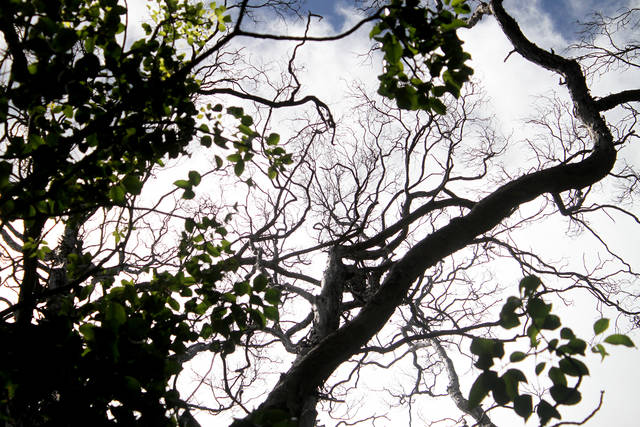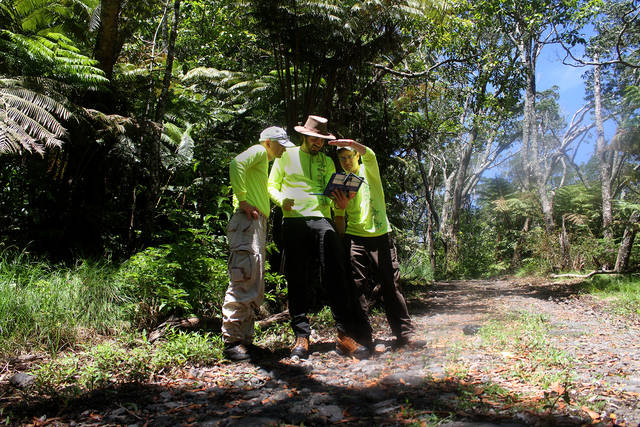HILO — When the Big Island Invasive Species Committee’s field crew heads out to take samples from ohia trees, no news is good news.
HILO — When the Big Island Invasive Species Committee’s field crew heads out to take samples from ohia trees, no news is good news.
The team has been on the ground since January, traveling from Kohala ranches to Hawaii Volcanoes National Park and just about everywhere in between. Its sampling work is one level in the ongoing quest to eradicate and better understand the devastating fungal disease known as rapid ohia death.
Caused by two species of Ceratocystis fungus, ROD has affected more than 75,000 acres of endemic ohia trees on Hawaii Island. Once in a tree, the fungus enters the ohia’s vascular system and cuts off access to nutrients and water. A tree can be infected for months before symptoms — browning leaves — appear, but once symptoms do show up the tree dies within weeks.
More than 200,000 ohia trees died between 2015 and 2016, with some research estimates placing the number closer to 300,000.
The rapid ohia death working group, a partnership of nonprofits, private landowners and federal, state and county agencies, has had to constantly adapt strategies of management, diagnosis and containment to keep up with new information about Ceratocystis and how it behaves.
Each agency has its own designated role, but BIISC’s team “moves between borders,” said team project leader Bill Buckley. “We’re trying to help wherever we can to bridge the gap (between groups).”
The crew receives funding through a variety of sources: a “Service First” grant from the U.S. departments of Interior and Agriculture, Hawaii Tourism Authority, state Department of Land Natural Resources’ Division of Forestry and Wildlife and Hawaii Invasive Species Council.
“Our role is a big-time support role,” Buckley said. “Everybody (else) gets a little more out of their day.”
In the early days of trying to solve the rapid ohia death mystery, nobody knew what was killing the trees.
“I was taking root samples at first and not finding anything,” recalled J.B. Friday, extension forester with the University of Hawaii College of Tropical Agriculture and Human Resources. “We didn’t know what we were looking for before.”
The BIISC team that collects samples knows exactly what it’s looking for. And diagnostic methods have changed considerably since the early days of the ROD outbreak, which started in the lower Puna area.
“When we initially discovered this disease, we were felling the (dead) trees and cutting them open (to diagnose),” Friday said. “Now we’re kind of in the stage of mapping it.”
On a recent Wednesday, Buckley and five other crew members headed to the Laupahoehoe tract of the Hilo Forest Reserve in a pair of pickup trucks, bumping up a winding dirt road through four separate gates before reaching a portion of forest that had been mapped by airplane flyovers in April.
Those flyovers turned up a number of dead and possibly infected trees. But ohia trees can die for any number of reasons. That’s where the sampling crew comes in.
The farther the trucks drove up the winding road, the more native species of plants field technician Timo Sullivan pointed out. Sullivan, along with Brett Gelinas and Dustin Swan, would be flying a drone over the forest to more accurately locate dead ohia. Looking up from the ground, brown leaves are harder to spot.
“It’s rare for us to work on actual native species,” Buckley said. Before January, the crew focused its efforts on eradicating invasive albizia trees, usually through herbicide application. Now they work on ROD about three-quarters of the time.
“For me, it feels really good that we’re doing rapid ohia death things now,” said field technician Jensen Walker, who is Native Hawaiian and was born and raised on the Big Island. “It’s (ohia) so important in Hawaiian culture.”
Walker and Buckley, along with intern Kristen Hofer, buckled machete belts on and pocketed portable radios before heading into the forest to find the first suspect tree.
The ohia forest in the Laupahoehoe tract is considered a high priority area for surveying. It’s here that the first documented Hamakua ROD case was found, last November.
That tree was a giant, more than 100 feet tall and estimated to be centuries old. Ohia can live more than 600 years — they are among the oldest types of trees in the Northern Hemisphere.
The first dead tree the BIISC trio approached had a trunk about 4 feet in diameter.
“They get bigger, but not much,” Buckley said.
At its base the ohia still looked very much alive, as it was covered in plants both native (olapa, hapuu) and invasive (ginger). Many native plants use ohia as a nursery site; the tree continues to provide for its environment even after it is dead.
The ohia tree had a ribbon of plastic tied around its thick trunk indicating the state’s DOFAW team had already sampled it at some point, most likely months ago. Buckley decided to resample it and the four other DOFAW-surveyed trees found that day, given that sampling protocol had changed recently and scientists were gaining a better understanding of how Ceratocystis traveled in a tree.
The two species of Ceratocystis fungus that affect ohia are new to science and in the process of being formally renamed. For now, they’re known as Species A and Species B. They infect ohia differently.
Inoculation studies completed earlier this year found that Species A moves quickly up through the entire tree.
“The B species just sort of grows through the sapwood, but it doesn’t break off and shoot up the highway of the vascular system,” Friday said. “B forms a very localized area of infection.”
When sampling first began, teams looked at just one spot on a tree. But doing that means an actual infection site might be missed.
Buckley used a hatchet to chip off a chunk of wood from the trunk, homing in on a spot that Hofer noticed had signs of insect activity. Boring beetles are thought to transmit rapid ohia death as they burrow into trees and create tiny motes of wood called frass. Frass is easily blown around by the wind, spreading Ceratocystis.
The inside of the tree also showed what looked like staining of the wood. Staining is one of the signs of infection, but Buckley cautioned that “there are so many things that could be.”
“Trees do have a lifespan, where their support structures and everything else is no longer to keep up,” Friday said. “There are a number of pathogenic fungi that attack old trees … they’re kind of humming along in the background, but not (to the point of) causing an outbreak. That’s why this new disease is so alarming.”
The wood sample went into a plastic baggie for testing, as did the frass. A newly developed portable laboratory system developed in partnership with the U.S. Geologic Survey allows people to test out in the field, rather than in the lab at the USDA Pacific Basin Research Center in Hilo.
The PBARC facilities are considered the gold standard, but the “lab in a box” has allowed USDA researchers Lisa Keith and Wade Heller to spend more of their time on actual Ceratocystis study and less on sample testing.
“We’re trying to alleviate the pressure on them,” Buckley said.
After taking wood samples from around the entire trunk, the crew sprayed black pruning seal over each hatchet wound. That way, if the tree did turn out to be infected, insects wouldn’t have easy access to the wood and transmitting the disease was minimized.
All three crew members wiped their hands with rubbing alcohol and sprayed the hatchet down with the same solution to decontaminate themselves and their tools.
“We do our best to decon and keep everything clean,” Buckley said.
Hofer used a tablet to enter basic information about the site, the tree and how sampling was collected into a survey system. The data went into an ARC-GIS mapping system as well, so anybody looking at a map of the forest would be able to know exactly when the tree was tested and how.
Overhead, Sullivan’s drone buzzed as it shot 360-degree video of the forest, looking for dead trees among the canopy.
The second tree BIISC tested had a trunk similar in size to the first. It, too, was hosting a small nursery of plants on its trunk.
Both sampled trees, though far larger than any ohia people would see at lower elevations, were smaller than the one that had first prompted surveys of the Laupahoehoe tract back in November.
“That was a difficult one for them to fell,” Buckley said.
Felling a dead but diseased ohia tree is a path of last resort, especially in high-value native forest. But given its positive diagnosis and the considerable threat of spreading Ceratocystis, the first Laupahoehoe tree was cut down, then covered with a tarp to prevent fungus from escaping (and insects from entering).
Staining and insect frass aside, though, the samples collected Wednesday all tested negative for Ceratocystis via the remote lab. The results are now being confirmed, which can take up to a month.
“We’ll come back to this site multiple times,” Buckley said.
“You can miss it, if it (the infection site) is higher up in the canopy and hasn’t (traveled) down yet,” Friday said. “If it were just a small infection, maybe it would take a lot longer, maybe it would take a year or two to infect the whole tree.”
Back at the trucks on the road, the BIISC team made plans for the next day of testing, which would be on the same tract of land. Sullivan’s drone had turned up a few possible suspects, but overall, the Laupahoehoe tract appeared to be thriving.
“Honestly, Bill, this forest looks really good,” Sullivan said.
“Yeah,” Buckley said. “Yeah, it does.”




